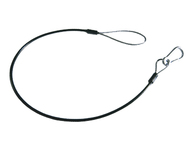
Safety Chains are an extremely important part of rigging,
they have one simple job, to stop the fixture from falling if the clamp fails.
The Safety is attached to the fixture and round the beam/bar it is hung off,
this way if the clamp fails the fixture should only drop a short distance
before the safety takes its weight. Most safety chains have weight ratings,
this tells you how much weight the safety chain can take, it is important to
use the correct safety chain for the fixture or it could break.
When hanging truss it is also important to use safety chains, here the chain should go through the truss and around a separate hanging point, this will protect against incidents where the hanging point is the point of failure. When mounting a safety to a truss it should never be weight bearing - taking the weight of the truss - but equally should not be loose as should the truss fall it should not move and apply a whip load onto the chain as this may overload it and cause the safety to fail. You will also need to consider the SWL - Safe Working Load - of the chain and all shackles, bolts and hanging points when building redundancy into your system as these all need to be able to take the full weight of the main hanging points as otherwise they will not function properly.
Safety chains can prevent serious injury and therefore are a INDUSTRY STANDARD REQUIREMENT. All fixtures must be rigged with a safety chain otherwise you could be liable for any damage/injuries however this does not mean if you add a safety that you are NOT liable for any damages/injuries. Always remember - If you can't afford to do it safely, you can't afford to do it. Safety cables are cheap, people aren't.
PLEASE NOTE - Once a safety cable has done its job and taken the weight of a fixture it needs to be disposed of and replaced with a new one.
When hanging truss it is also important to use safety chains, here the chain should go through the truss and around a separate hanging point, this will protect against incidents where the hanging point is the point of failure. When mounting a safety to a truss it should never be weight bearing - taking the weight of the truss - but equally should not be loose as should the truss fall it should not move and apply a whip load onto the chain as this may overload it and cause the safety to fail. You will also need to consider the SWL - Safe Working Load - of the chain and all shackles, bolts and hanging points when building redundancy into your system as these all need to be able to take the full weight of the main hanging points as otherwise they will not function properly.
Safety chains can prevent serious injury and therefore are a INDUSTRY STANDARD REQUIREMENT. All fixtures must be rigged with a safety chain otherwise you could be liable for any damage/injuries however this does not mean if you add a safety that you are NOT liable for any damages/injuries. Always remember - If you can't afford to do it safely, you can't afford to do it. Safety cables are cheap, people aren't.
PLEASE NOTE - Once a safety cable has done its job and taken the weight of a fixture it needs to be disposed of and replaced with a new one.